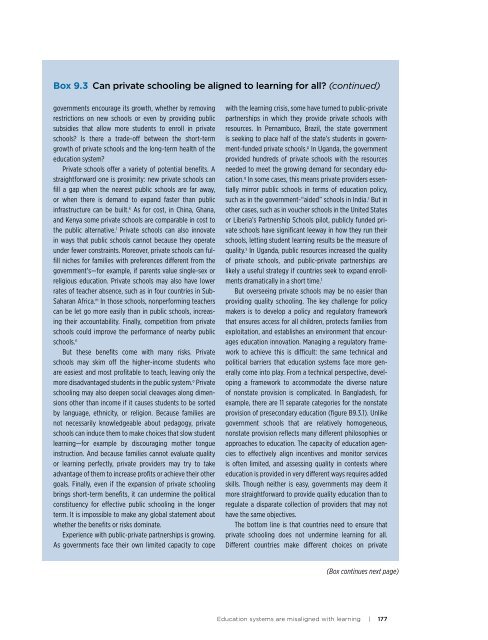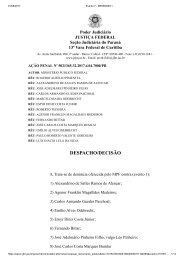Brasil só deve dominar Leitura em 260 anos, aponta estudo do Banco Mundial Relatorio Banco Mundial _Learning
Create successful ePaper yourself
Turn your PDF publications into a flip-book with our unique Google optimized e-Paper software.
Box 9.3 Can private schooling be aligned to learning for all? (continued)<br />
governments encourage its growth, whether by r<strong>em</strong>oving<br />
restrictions on new schools or even by providing public<br />
subsidies that allow more students to enroll in private<br />
schools? Is there a trade-off between the short-term<br />
growth of private schools and the long-term health of the<br />
education syst<strong>em</strong>?<br />
Private schools offer a variety of potential benefits. A<br />
straightforward one is proximity: new private schools can<br />
fill a gap when the nearest public schools are far away,<br />
or when there is d<strong>em</strong>and to expand faster than public<br />
infrastructure can be built. k As for cost, in China, Ghana,<br />
and Kenya some private schools are comparable in cost to<br />
the public alternative. l Private schools can also innovate<br />
in ways that public schools cannot because they operate<br />
under fewer constraints. Moreover, private schools can fulfill<br />
niches for families with preferences different from the<br />
government’s—for example, if parents value single-sex or<br />
religious education. Private schools may also have lower<br />
rates of teacher absence, such as in four countries in Sub-<br />
Saharan Africa. m In those schools, nonperforming teachers<br />
can be let go more easily than in public schools, increasing<br />
their accountability. Finally, competition from private<br />
schools could improve the performance of nearby public<br />
schools. n<br />
But these benefits come with many risks. Private<br />
schools may skim off the higher-income students who<br />
are easiest and most profitable to teach, leaving only the<br />
more disadvantaged students in the public syst<strong>em</strong>. o Private<br />
schooling may also deepen social cleavages along dimensions<br />
other than income if it causes students to be sorted<br />
by language, ethnicity, or religion. Because families are<br />
not necessarily knowledgeable about pedagogy, private<br />
schools can induce th<strong>em</strong> to make choices that slow student<br />
learning—for example by discouraging mother tongue<br />
instruction. And because families cannot evaluate quality<br />
or learning perfectly, private providers may try to take<br />
advantage of th<strong>em</strong> to increase profits or achieve their other<br />
goals. Finally, even if the expansion of private schooling<br />
brings short-term benefits, it can undermine the political<br />
constituency for effective public schooling in the longer<br />
term. It is impossible to make any global stat<strong>em</strong>ent about<br />
whether the benefits or risks <strong>do</strong>minate.<br />
Experience with public-private partnerships is growing.<br />
As governments face their own limited capacity to cope<br />
with the learning crisis, some have turned to public-private<br />
partnerships in which they provide private schools with<br />
resources. In Pernambuco, Brazil, the state government<br />
is seeking to place half of the state’s students in government-funded<br />
private schools. p In Uganda, the government<br />
provided hundreds of private schools with the resources<br />
needed to meet the growing d<strong>em</strong>and for secondary education.<br />
q In some cases, this means private providers essentially<br />
mirror public schools in terms of education policy,<br />
such as in the government-“aided” schools in India. r But in<br />
other cases, such as in voucher schools in the United States<br />
or Liberia’s Partnership Schools pilot, publicly funded private<br />
schools have significant leeway in how they run their<br />
schools, letting student learning results be the measure of<br />
quality. s In Uganda, public resources increased the quality<br />
of private schools, and public-private partnerships are<br />
likely a useful strategy if countries seek to expand enrollments<br />
dramatically in a short time. t<br />
But overseeing private schools may be no easier than<br />
providing quality schooling. The key challenge for policy<br />
makers is to <strong>deve</strong>lop a policy and regulatory framework<br />
that ensures access for all children, protects families from<br />
exploitation, and establishes an environment that encourages<br />
education innovation. Managing a regulatory framework<br />
to achieve this is difficult: the same technical and<br />
political barriers that education syst<strong>em</strong>s face more generally<br />
come into play. From a technical perspective, <strong>deve</strong>loping<br />
a framework to accommodate the diverse nature<br />
of nonstate provision is complicated. In Bangladesh, for<br />
example, there are 11 separate categories for the nonstate<br />
provision of presecondary education (figure B9.3.1). Unlike<br />
government schools that are relatively homogeneous,<br />
nonstate provision reflects many different philosophies or<br />
approaches to education. The capacity of education agencies<br />
to effectively align incentives and monitor services<br />
is often limited, and assessing quality in contexts where<br />
education is provided in very different ways requires added<br />
skills. Though neither is easy, governments may de<strong>em</strong> it<br />
more straightforward to provide quality education than to<br />
regulate a disparate collection of providers that may not<br />
have the same objectives.<br />
The bottom line is that countries need to ensure that<br />
private schooling <strong>do</strong>es not undermine learning for all.<br />
Different countries make different choices on private<br />
(Box continues next page)<br />
Education syst<strong>em</strong>s are misaligned with learning | 177








